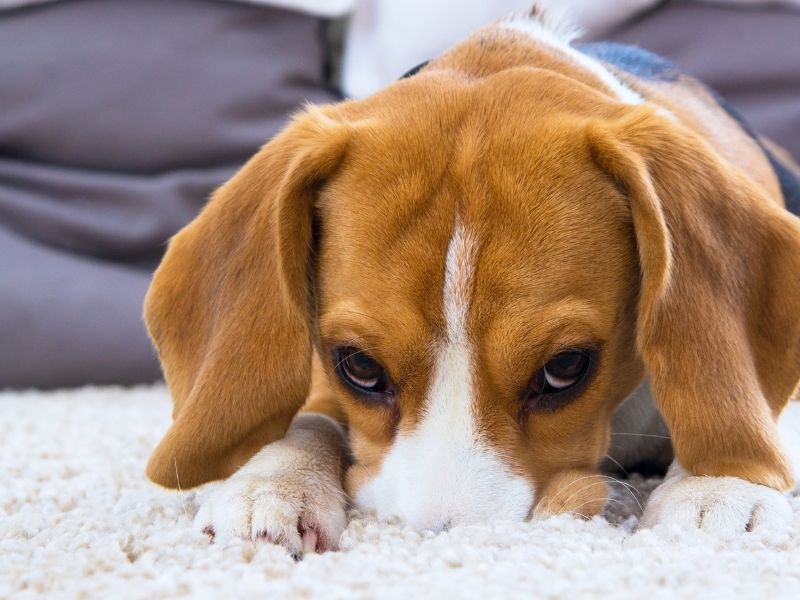
How to Stop a Dog from Marking in the House for Good
This post may include affiliate links. Please read my disclosure policy.
Urine marking is a common behavior, particularly in male dogs. Dogs mark with their urine to assert ownership of objects and areas, leaving a scent message for other dogs. Female dogs mark with their urine too, especially during their heat cycle. This natural behavior is a way for dogs to communicate and establish social hierarchy.
What’s the Difference Between Peeing and Marking?
Your dog may pee inside if they haven’t been let out enough, if they have a small bladder, or for many other reasons. But the peeing will result in a full puddle of urine.
Whereas, in marking, you’ll only find a small amount of urine, and it’s often found on the same spot or object.
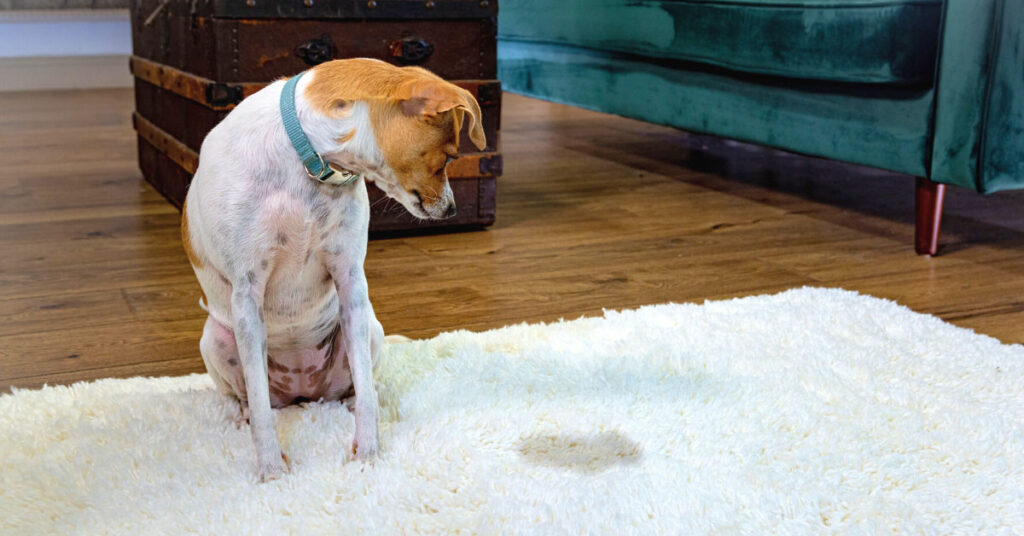
It’s considered natural behavior when dogs mark a certain spot, but it’s certainly not acceptable in the house. Furniture, floors, walls, and other items are ruined or damaged when your dog decides to claim them as his own.
Urine marking is not the result of faulty housebreaking. In fact, most of the time, urine marking can be curbed with behavior modification.
Why Is Your Dog Marking in Your House?
One of the most common reasons dogs start urine marking inside your home is the addition of anything or anyone new, be it a new dog or cat, a baby, a new partner, or even new furniture. This behavior can be particularly prevalent in multi-dog households where there’s competition for resources, attention, or status. By territory marking, a dog is basically saying, “This is my space. Keep out.”
Other triggers may be stress, like moving to a new home or even a change in your and your pup’s routine. Certain forms of anxiety, like separation anxiety, can also cause this behavior. Dogs urine mark as a coping mechanism, providing them with a sense of security and familiarity in response to perceived threats or changes.
If your dog urinates more frequently in your home, this may also indicate underlying health issues. Certain diseases may result in increased urination, which can be misconstrued as marking behavior.
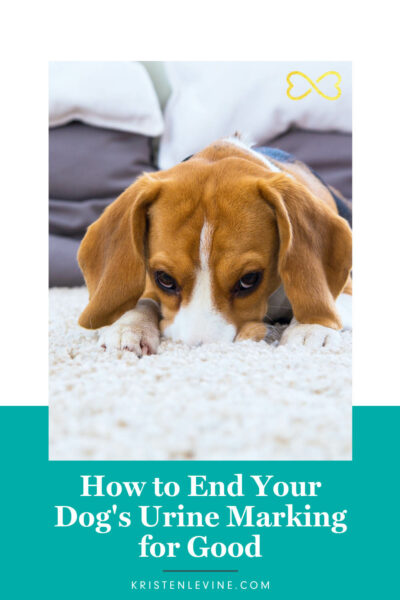
How to Stop Dog Marking in the House
Spay or Neuter Your Dog
For both female dogs and male dogs, spaying or neutering will reduce or stop marking behavior. According to the North American Veterinary Community, as many as 50% of male dogs stop scent marking, or at least do it significantly less often, after being neutered.
Intact male dogs usually begin marking when they start to reach sexual maturity.
If you have a puppy, neutering him as soon as he’s old enough is one of the best ways to stop indoor marking from starting in the first place.
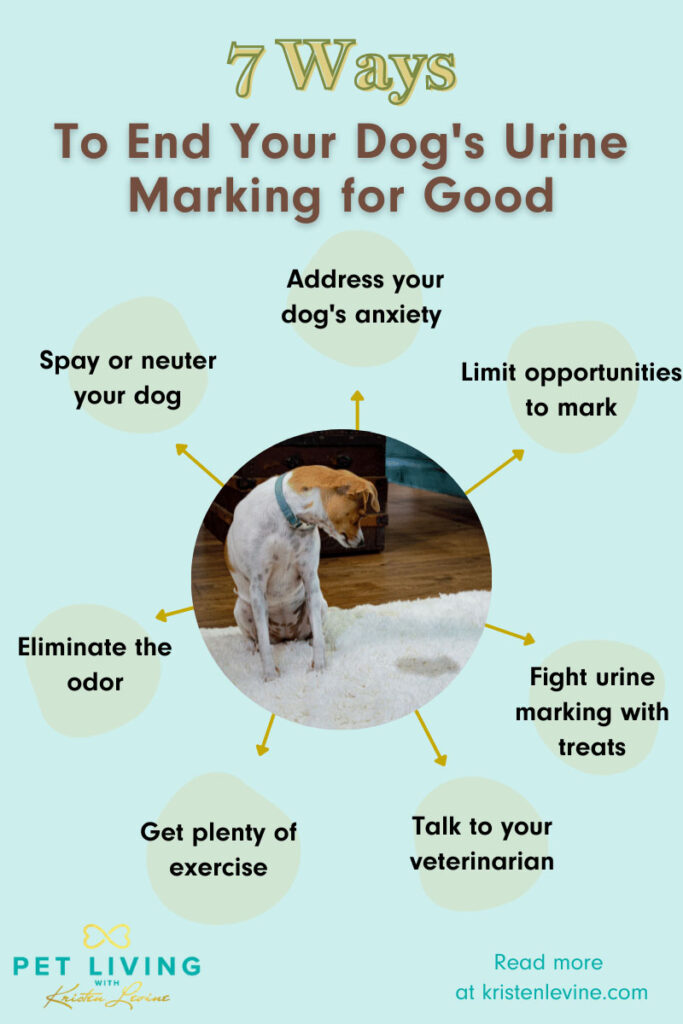
However, it may be days or even weeks for the urine marking behavior to stop after your dog is altered since hormones gradually decline rather than come to a screeching halt.
And it will likely also take some additional house training on your part to change the marking behavior if it has become a deeply ingrained habit.
If your male dog is peeing in the house weeks or months after he’s altered and after you’ve taken the steps below, there could be other behavioral or physical issues that need to be addressed.
Address Your Dog’s Anxiety
If your dog’s marking is caused by something like separation anxiety, you’ll want to address it sooner than later, especially since anxiety can escalate as your dog ages.
This is one reason why it’s important not to yell at your dog when he marks. If he’s doing it out of anxiety, yelling may make it much worse.
Some dogs experience noise anxiety, social anxiety, or separation anxiety. These fears can make a dog react with unwanted behaviors, like urine marking.
There are several OTC (over-the-counter) anxiety tools that can help alleviate your pup’s anxiety. I love this pheromone collar from Adaptil.
My dog, Chilly, had severe anxieties, especially around loud noises, and this collar was a very effective tool we used to manage it. The pheromones have a calming effect on some dogs and can reduce the urge to mark. There is also a room diffuser if you prefer that.
There are also many food-based remedies for calming anxiety, including calming probiotics and calming foods.
Ultimately, if your dog has anxiety, you may need to enlist the help of a veterinary behaviorist to work through it. You can find a behaviorist in your area using this page on the dacvb.org site.
You can also check out my pet anxiety resource page for more information about anxiety signs and solutions.
Eliminate the Odor
As long as the odor from your dog’s urine is still there, he’ll likely continue to mark the same spot. So it’s important to clean it up correctly, with a bio-enzymatic cleaner designed to eliminate biological waste, like urine. Be sure to let these completely dry to eliminate all traces of organic matter.
An enzyme cleaner works by eating the bacteria that’s causing odor and stains. Ordinary household cleaners will do little to eliminate the mess. If you’re in doubt, take a black light to any mess you’ve cleaned without using a bio-enzymatic cleaner, and you’ll be convinced!
Kinderbean No-Stress Mess Eraser is, paws-down, the best cleaner for pet mess, in my opinion. I’ve tested a lot of cleaners, and most have come up short in one way or another.
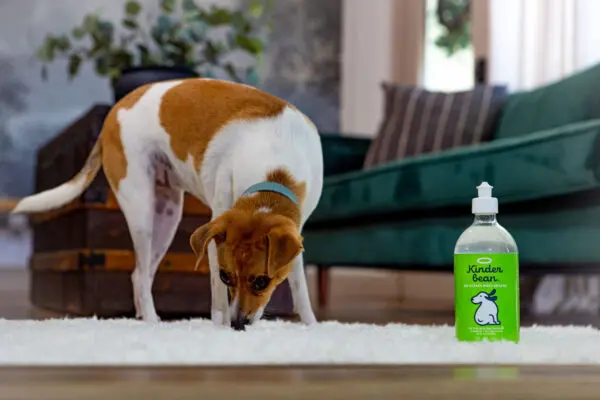
Whichever cleaner you choose, make sure it is:
- Bio-enzymatic
- Safe for pets (both in chemical composition and odor)
- Doesn’t contain harsh dyes that could discolor surfaces
- Contains natural ingredients
- Has a durable dispenser (many have cheap spray tops that break in shipping)
Once you have your cleaner, you need to use it properly to make sure it eliminates the odor.
- Soak up as much urine as possible with a paper towel.
- Saturate the spot with the cleaner. This is important so it can make contact with the urine and eat the bacteria.
- If the spot is horizontal, lay a clean cloth over the top and allow it to set overnight or 12–24 hours. If the spot is vertical, allow the cleaner to air dry.
- Retreat if necessary.
It’s a very simple process, but it’s so important not to simply “spray and wipe away.”
- Enzyme-Powered Cleaner: Simple ingredients, powered by plants. Powerful, bio-enzymatic formula biodegrades odor and stain molecules leaving nothing behind.
- Any Stain, Any Surface: Erases pee, poop, vomit, blood and scoot stains from all floor and furniture surfaces including carpets, upholstery, hard floors and more - even cleans leashes, collars and pet bedding.
- Easy to Use: In just three steps, this ready-to-use cleaning formula will erase messy stains and odors for good - no mixing, just shake and go.
- Safe for Pets & the Earth: Our non-toxic blend of safe probiotics and naturally occurring enzymes have no harsh chemicals, no scary additives, no residue and no possibility of harm to your family or pets.
- Created by a Pet Expert: Pet industry veteran and lifelong pet parent Kristen Levine created Kinderbean to make loving pets easier, messes and all.
Fight Urine Marking with Treats
Most dogs won’t pee where they eat. Change the meaning of the place he has marked by leaving treats directly on the spot after cleaning it.
Consistency is key here because as soon as you’ve banished one area as a pee spot, your dog may choose a new area. It may take weeks before your dog realizes the entire house is off-limits to territory marking. But this solution is usually permanent, so it’s worth the wait.
I like to use these treats because they’re low in calories and all-natural. When you’re dog training, you’ll go through a lot of treats, so you don’t want to give them full-size bones or cookies that will pack on unhealthy pounds.
Get Plenty of Exercise, Both in Body and Mind
Breeds known for their high energy or above-normal intelligence are in special need of exercise. Getting out that pent-up physical or mental energy can help calm your dog and avoid behavioral issues, such as marking.
If you’re already walking your dog and he’s still peeing indoors, you may need to step up your game and either walk him longer or take him for a run.
If running doesn’t get you paws-itively excited, try taking your dog to the park for a game of high-intensity fetch. One of my favorite fetch toys is the ChuckIt! Ring Chaser. It allows you to throw a ring-like toy long distances without tiring out your arm. Plus, it bounces and rolls in ways that are really enticing to our energetic pooches!
Brain stimulation is also important, so come up with creative games or tricks to teach your pet. Not only will it give your pup a purpose, it comes with the benefit of increased bonding time with you!
Exercise may seem like a very simple step, but it’s probably one of the most important!
Limit Opportunities to Mark
If your dog is a stubborn marker, you may need to take stricter measures to curb the behavior.
Some experts recommend the umbilical cord method. When your dog is inside, he’ll remain leashed to you so you can closely monitor him. As his behavior improves, you can gradually give him more freedom to explore the house.
I’ve tried this method to housebreak my dog, Tulip, and it works fantastically. I’ll caution, though, that you do need a lot of patience and consistency to see results.
When to See Your Veterinarian
In most cases, behavior modification is enough to curb your dog’s urine marking. However, in some cases, urine marking can be caused by medical issues.
Your dog may have begun marking because of a urinary tract infection, and the only way to know for sure is to visit your veterinarian.
If your dog has begun marking and there doesn’t seem to be any apparent trigger, it’s time to visit your veterinarian to rule out anything that needs treatment.
Additionally, if your dog has extreme anxiety that’s causing the urine marking, you may need to seek help from a veterinary behaviorist. They can help get your dog the relief he needs and recommend more ways and methods on how to stop a dog from marking in the house.
When Is Urine Marking Acceptable?
When you’re walking your pup, urine marking outdoors should be all right. If you’re in an area where marking would not be acceptable, perhaps like your neighbor’s beloved garden or flower bed, take note of any tell-tale signs that your dog is about to mark, like prolonged sniffing. Lead your pup away from the area by encouraging them to move along (use the voice that you know gets lots of wags) and offer treats if you have any on you.
The Tail End
If your dog is urine marking in the house, rest assured it’s not because he wasn’t house trained enough. Urine marking is a behavior, and with behavioral modification along with neutering your dog, you can stop marking for good.





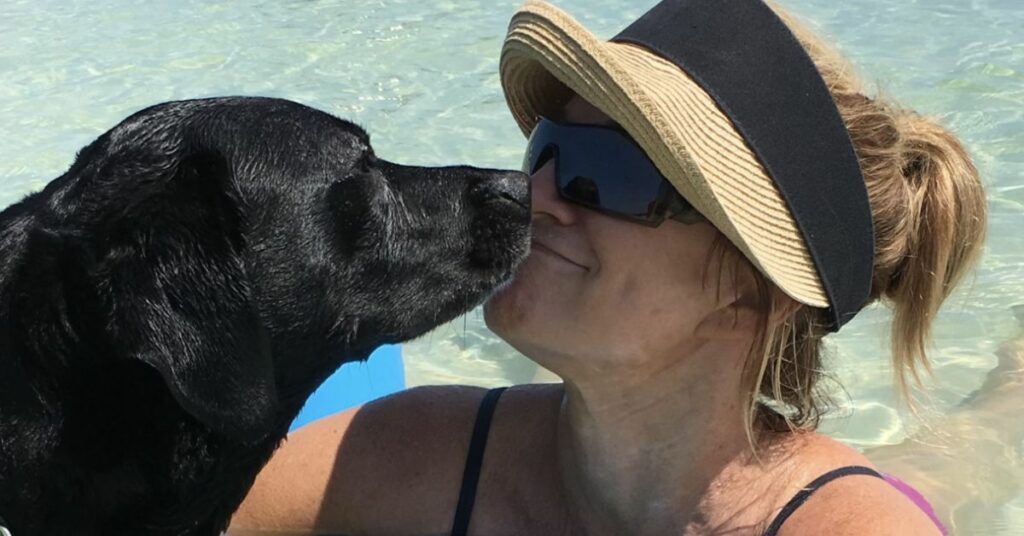
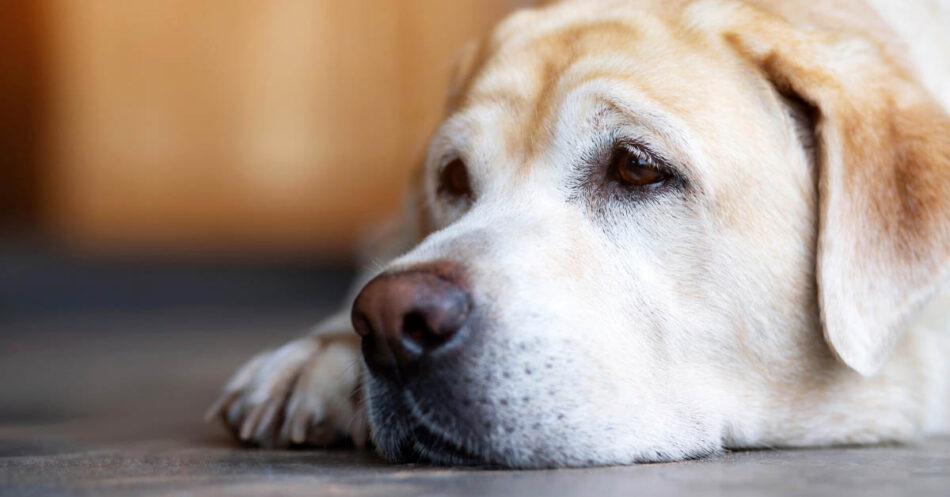
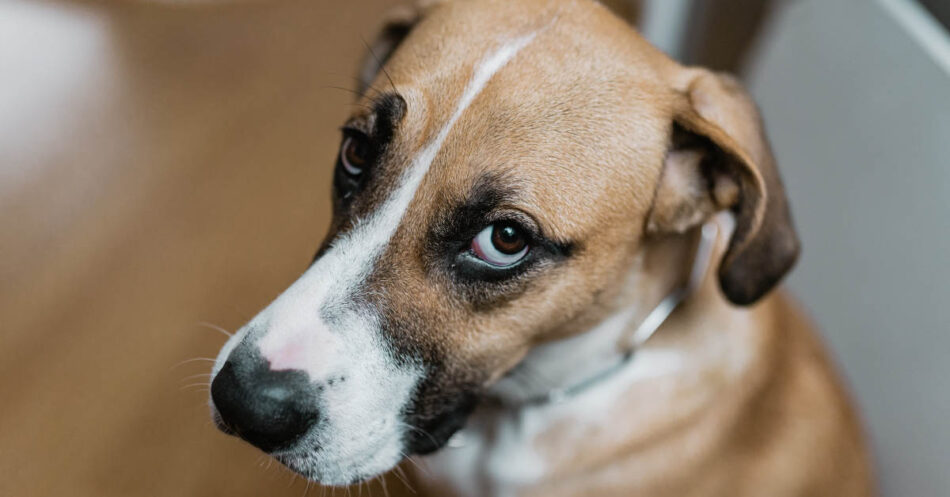
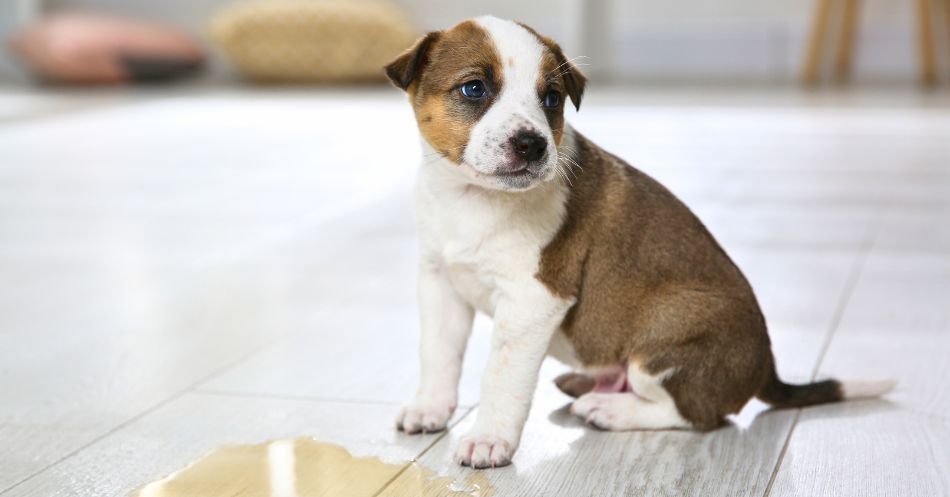
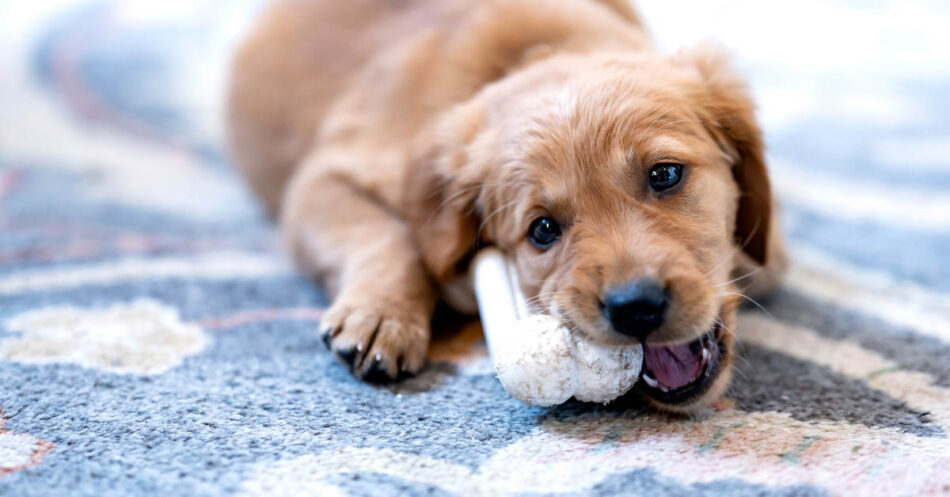
Ach! So glad I Googled “dog marking in house” which lead me to this resource!
7 mos ago we adopted a neutered 13-mo old Golden Retriever from his first family. They did not have the time for him (he was NOT abused) & he spent a great deal of his days in a crate. Super sweet boy, smart as a whip, & a great personality.
He joined my husband & me, our inside cat, & our 3-yr old Black Lab.
One month after adopting him we moved house, which we have been in 6 mos now.
Over the past 6 mos, we have had on-again/off-again problems with GR pooping & pottying in the house. Pooping has been sorted but we determined the pottying seems to be marking. BUT he only seems to do so when he & my BL are roughhousing. Is it possible that the play & marking are connected? It also is not every time. There hasn’t been an accident in 5 weeks & tonight *wa-la!* marked the back of my couch & a dog bed.
All I can think to do is belly band him all the time he is out of his crate in the house whether we are in the room with him or not. We went so long between accidents that I thought we had it sorted…I just feel defeated.
Would appreciate your thoughts re: correlation between play/marking, how long until we can consider this sorted, is our plan of belly banding a good start?
*fingers crossed*
Hi Emily,
Don’t feel defeated! It’s possible to solve the problem with some patience and trying various things.
First,I’d talk to your vet about the behavior to rule out a medical issue and to get some advice on behavior modification. It does sound like he’s marking territory to show your BL who’s boss, LOL.
Sometimes dogs mark due to anxiety. I’m not sure if this is your situation, but you can try to calm him with a pheromone collar like this one.
You can definitely use the belly band, but it’s not very convenient. Plus, you never know when he’s going to mark and you don’t want him to have to wear it 24/7.
Keep in mind that his life now is very different than before, so he may be adjusting to his newfound freedom. Try giving him a bit more crate time to rest, and be sure to let him go potty before he goes in, and immediately when he comes out.
Let me know if any of this advice gets you results!
Kristen
Appreciate the feedback, Kristen; thanks.
I have reached out to our vet who suggested an animal behaviorist as he (my vet) does not feel that it’s medical. We’re pending scheduling…
GR *does* have a calming collar which I have put on him when he seems agitated…I never thought that even while playing (& having what looks like fun) that he may still be a bit anxious; I’ll try him wearing that more often.
You’re right! The belly band is not overly convenient so we must sort this out for the long term. For sure.
The extra crate time makes sense too.
Thanks – we’ll see how it goes & I’ll let you know 🙂
Hello, we have recently adopted a 4 year old rescue segugio Italiano. He is perfect!
However once he has eaten some of his food and had a drink, he will urinate on the corner of the door frame by his bowl.
We don’t have any other dogs and haven’t had any in the house where he has urinated. He has done it every day we have had him despite taking him outside for the toilet literally 5 minutes before this happened.
If we catch him in the act we try to stop/interrupt him by clapping and immediately take him outside but he won’t then continue urinating once outside. I think it may be a territorial issue but not sure how to really stop it. Help please?!
Hi Hannah,
It does sound like he’s marking. Considering that he’s 4 and you recently adoped him (good for you!), this behavior may have been going on for a long time. Or, he could be marking because he’s in a new home.
I’d recommend talking to your vet first to rule out a medical issue. He/she may also be able to suggest some behavior modification to stop the marking the door frame.
If this is the ONLY time he marks, you might try putting a belly band on him right before he eats, then, when he goes to pee/mark, the belly band will absorb it. However, he may choose not to mark with the belly band on, but it might be worth a try until you can speak to your vet.
Also, sometimes dogs mark because they are anxious. You might try putting a pheromone collar on him. I use this one to reduce anxiety when my dog is upset.
Let me know if you have success with any of the above!
Kristen
Hi Kristen
I have a 4 year old scweenue she pees on couches I had to replace one after one year I just got a new one I’ve been keeping them off the couch put beds around the couch don’t allow them on the couch and she managed to get up there and P on the new couch I’m at my wits end with this dog and I’m not sure what to do I give her plenty of treats and attention. She does get in trouble when she peas on things with a little smack on the butt sometimes a bit of yelling on my part and I put her outside in the yard for a few hours! She is very smart and funny but I cannot deal with this behavior I have 4 dogs! The 3 including her have been together for years! My new rescue is unaltered but she was peeing g way before that! Hug help!
Hi Christy,
I’m sorry your 4 year old pup is peeing on the couch! I suggest the following:
Take her to the vet and explain the behavior she’s exhibiting. Sometimes, there’s a medical reason for this peeing on things.
Second, she may be stressed or anxious due to your other dogs. Some dogs pee on things in the house when anxious. Try putting a pheromone collar on her. This collar mimics a natural calming hormone in dogs and may help to stop her peeing.
Have you tried taking her outside more frequently to pee? Some small dogs just don’t have good bladder control. Also, try blocking the sofa so she can’t get up there or keep her confined to a part of your home until you get to the bottom of why she’s peeing inside.
Keep me posted!
Kristen
I have 3 male daschunds – all have been neutered. One I have had for over 5 years and the other 2 we just received from someone who was unable to care for them and we immediately had them neutered. They are constantly marking everything! Our carport and patio stink like a uncleaned kennel. What can I do to prevent this?
Hi Steve,
If they were just recently neutered, things may get better in time. But if it’s been awhile, they might be marking due to some anxiety. If they were surrendered by another family, that could be causing them stress enough to be marking. Also, you can try reducing anxiety with an Adaptil pheromone collar for each of them.
You can also limit the marking by limiting the time they have to run free in the house. Try crating them for a few hours during the day — let them out to pee before going in the crate and immediately after.
If that doesn’t help, I would take them to the vet and explain how badly they are marking everything. The vet can rule out any possible medical conditions and may be able to recommend behavior modification or medication to reduce or stop the marking.
Let me know what happens. I know this is maddening!
Kristen
Frustrated doesn’t explain how we feel. Got Dog 1, a chihuahua, as a rescue 11 years ago. He was never fully house trained but it didn’t seem to be a huge problem to deal with. Got Dog 2, 25 pound rescue who is now about 6 years old. We’ve had him since he was 1. He is house-trained, BUT is now peeing/marking daily. They both are. The little one can’t hold too much but the big one lets loose. The back door is always open but they pee/mark on the baseboard, ‘fridge, furniture, and on the couch- even on the couch pillows. We just threw out a couch that was ruined beyond repair and have a new one. After two weeks, today Dog 2 peed on a pillow, which ran down on the couch. We clean, use Nature’s Miracle, I’ve used bleach solution on top of that too. Nothing is working and we are having trouble living like this. We do have a third dog, a small female chihuahua, who is fully house trained. She joined us a year ago, but the other two (boys) were doing this well before she arrived and nothing has changed since she’s been here. All are fixed. All are healthy. We cannot continue to clean up six or seven times a day. Help?
Hi Elizabeth,
Wow, you must be losing your mind. You say everyone is spayed, right? It’s possible that dog 1 and dog 2 are marking for one of a few reasons — asserting dominance (happens even when fixed) or anxiety reasons or they are just so accustomed to it, they keep doing it.
This sounds like a problem I would take to a veterinary behaviorist because they specialize in treating or modifying unwanted behaviors. Plus, they are veterinarians so they look at the problem from a medical and psychological standpoint.
You can find a veterinary behaviorist near you here. You can start with your family veterinarian too as he or she may know a behaviorist they like to refer to.
As far as cleaning the messes. be sure to use an enzymatic cleaner and apply enough of it to soak the stain. Agitate the liquid into the stain and cover it with a cloth and let sit for 12-24 hours to dry.
You can also limit the behavior by limiting where the dogs are allowed to go. Can you crate them during parts of the day to reduce the time they have to mark?
I’m so sorry you’re having such trouble. Keep me posted on what happens.
Kristen
Hello- I came across your page while researching tips for potty training our 13 week old Great Pyrenees. He barks to go out to poop and won’t poop in the house but he pees in the house constantly! I will be outside with him for an hour and we will come in and he will immediately pee on the floor right in front of me. We say “no!” Loudly and he knows he did something bad because he will dash away and hide his face. Sometimes I catch him midstream and can get him outside to finish- he will pee outside a few times a day and gets lots of praise when he does but still will pee on the floor inside. I don’t know if he is doing it to “mark” (we have two fixed male cats in the home who he’s just getting acclimated to) because it’s not just little amounts but whole regular pees.
I’ve started to limit his water a bit, especially at night, as he will drink a whole bowl if it’s there and we take him outside almost every hour to two hours to encourage peeing outside.
I hope he will grow out of this phase but is there something I’m doing wrong or is there anything I can do to get him to ask to go out to pee like he does to poop?
Thanks!
Rebecca
Hi Rebecca,
I bet that puppy is adorable! Except when he pees in the house, right?
The good news is that it’s normal for a puppy to take some time to housebreak. You say he’s just 13 weeks old? That’s really young so I would not expect him to be totally housebroken yet. It’s great that he’s pooping outside!
Here are some suggestions. You may be doing some already, but it might help to try to make sure you’re doing some or all of these things:
Take him out every hour on a leash to pee. As soon as he pees outside, praise him, give him a yummy treat and take him off the leash (assuming you have a fenced yard). We want him to know how happy it makes you when he pees outside and that it means good things for him.
When he’s inside, keep him in a crate for an hour or two at a time and be sure to let him outside to pee before you put him him in the crate and immediately after you take him out of the crate. Same thing as above, when he pees outside, praise, treat and unleash.
When he’s inside and not in the crate, you need to keep him close to you so I suggest you put him on a 6 foot leash at all times. That way, if he starts to wander away to pee on the rug/carpet, you will catch him and redirect him outside.
If you take him outside and he just won’t pee. Bring him inside for just a few minutes, either crating hin or keeping him leashed,then go outside again. As soon as he pees, praise, great, unleash.
He will get it eventually, I promise! Just have patience and stick to a routine that helps him understand what you want from him. He just doesn’t get it yet. When you scold him for peeing inside, he may not understand yet….
You can do this! Keep me posted.
Kristen
Hi! I have a 1.5 year old pomeranian who has been neutered. Right after he got neutered he was doing a little better with the marking but I have since then moved and he’s back at it again (it never fully stopped). I have anti-marking spray, enzymatic cleaners, he gets to go out on the patio whenever he wants, and I have a pee pad in the house. Nothing seems to be working. He will even lift his leg on my comforter in my room and has ruined one already. I’m at a loss at this point. He seems to have anxiety so I’ve started him on CBD treats, too, and not much improvement in any of his behavior. I’m starting to resent him even though I really love him, and I don’t know what else to do 🙁 please help!
Hi Katie,
I get it. It’s so frustrating! I suggest you take him to see your vet and talk about this problem. You might even need a veterinary behaviorist because they specialize in getting to the bottom of unwanted behaviors of all kinds — including marking.
They can help with behavior modification or medication.
In the meantime, I would keep him in his crate for a few hours a day to simply reduce his access to where he marks. You can also keep him on a leash in the house so he can’t stray away from you to mark, without you knowing what he’s about to do.
That isn’t convenient of course, but until you have an understanding of why he’s doing it, you can limit the marking simply by limiting his freedom. Just be sure he’s getting walks and exercise.
One more thing, try this Adaptil pheromone collar. It reduces anxiety in dogs and might help. I have found it to be effective on my own dog who gets very anxious during thunderstorms. It’s worth a try!
Kristen
Hi!!! I am super excited to find this. My sweet 5 year old Cairin Terrier, Biggie is nutered. His marking has been a challenge for a long time. It is starting to ruin floors, comforters and my parents don’t want him in their house. We always take him on vacations with us, but due to his marking we can’t anymore. I spray essential oils on his most common areas. He doesn’t seem to suffer from anxiety that I can tell. He loves my kids and playing with them. He goes outside constantly and will come back in and mark. My husband has had it. We never can catch him in the act as he is pretty sneaky about it, but with 3 kids it’s a busy household. Please help me – my husband is so mad and I am scared his next option is to get rid of him. I cannot let that happen.
Hi Amanda,
I’m so sorry you’re having trouble with Biggie marking. You said he’s neutered and he’s not anxious. Have there been any changes at home? New pets, have you moved? Sometimes the marking behavior is due to changes in their environment.
My advice is two-fold. First, make an appointment to talk to your vet about this behavior. He or she will be able to rule out any possible medical problem and they may recommend specific behavior modification or even medication. Maybe not ideal, but this is a desperate situation!
Also, try these Pop Up Pee Pads. See if he will “mark” on the fire hydrant instead of floors and comforters. I’ve heard they have worked for some male dogs who mark.
Keep me posted and good luck!
Kristen
Hello! I have a 4 year old yorkie-poodle mix and although she is fixed she has always displayed territorial behaviour. I recently took her to my new boyfriend’s house and she tried marking within the first minute of being there! I felt so bad and embarrassed so we spent the rest of the evening playing in the backyard because I was too afraid to take her in and have that happen again! He said another dog has not lived there in 3 years and he cleaned the carpets before he moved in, but the family before him did have a dog. What steps can I take the next time I bring her to prevent this from happening? I don’t know what to do!!
Hi Danie,
I’m sorry to hear about your yorkie-poodle’s marking behavior! Some dogs urine mark whenever they go to new places or at home, when you bring new objects into the home. It could also be the result of her feeling anxious in a new place.
I would either not bring her over next time, or, if you do, keep her on a leash so you can monitor her behavior.
If the behavior is anxiety related, you might try a pheromone collar — a natural way to calm dogs. I like this one by Adaptil.
Finally, I’d take her to see the vet so he or she can rule out any medical issues.
Good luck!
Kristen
We have 7 year old Pomeranian. He marked all the time in side and out side. On the wall in the house we designate an area on the wall. Every morning we hang an unused pee pad using scotch tape. He pee on it after picking his leg. Scotch tape was not working. Now I came up something more permanent to hold the pad on the wall. I am working on making a die for reproduction.
Hi Dean,
What a smart idea! I found this Pop Up Pee pad that might be helpful too.
If you get your product to market, let me know and I’ll feature it.
Kristen
I need help 😭 I have a 7 month old male French bulldog who (aside from his marking) is completely house trained. I’m getting so frustrated because the only place he marks is on our beds! On mine and my husbands bed and on my 2.5 year old daughters bed and I’ve had enough of it! My husband doesn’t want to neuter him because he wants to stud him when he’s a little older but I just don’t know what else to do to get him to stop. I never notice him do it until it’s bedtime or nap time and we get on the bed and feel it wet. I am so so over this!
Hi Catherine!
I’m so sorry about your marking Frenchie! Yes, neutering will potentially end this behavior, or at least improve the behavior.
But if hubby isn’t having it, try these Pop Up Pee Pads. They have worked for some people who have marking male dogs. Try putting it on the floor by the bed first and if he still marks the bed, put it on the bed.
Let me know if this works!
Kristen